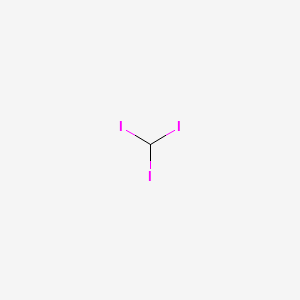



1. Tri-iodomethane
1. Triiodomethane
2. 75-47-8
3. Methane, Triiodo-
4. Carbon Triiodide
5. Jodoform
6. Chi3
7. Trijodmethane
8. Nci-c04568
9. Iodoformum
10. Nsc-26251
11. Chebi:37758
12. Kxi2j76489
13. Ncgc00091389-01
14. Dsstox_cid_743
15. Dezinfekt V
16. Dsstox_rid_75765
17. Jodoform [czech]
18. Dsstox_gsid_20743
19. Iodoform [jan]
20. Trijodmethane [czech]
21. Cas-75-47-8
22. Ccris 346
23. Hsdb 4099
24. Iodoform [usp:jan]
25. Einecs 200-874-5
26. Nsc 26251
27. Unii-kxi2j76489
28. Methyl Triiodide
29. Ai3-52396
30. Iodoform (tn)
31. Tris(iodanyl)methane
32. Mfcd00001069
33. Iodoform, 99%
34. Iodoform [hsdb]
35. Iodoform [inci]
36. Iodoform [mi]
37. Wln: Iyii
38. Iodoformum [hpus]
39. Iodoform (jp17/usp)
40. Iodoform [mart.]
41. Iodoform [who-dd]
42. Iodoform, Saj First Grade
43. Chembl1451116
44. Dtxsid4020743
45. Iodoform [usp Monograph]
46. Nsc26251
47. Zinc6827595
48. Tox21_111124
49. Tox21_202389
50. Tox21_302774
51. Akos009031506
52. Iodoform, Purum, >=99.0% (at)
53. Db13813
54. Iodoform, Puriss., 99.0-100.5%
55. S12111
56. Ncgc00091389-02
57. Ncgc00091389-03
58. Ncgc00256394-01
59. Ncgc00259938-01
60. As-14199
61. Ft-0627266
62. D01910
63. A838427
64. Q412393
65. J-650249
| Molecular Weight | 393.732 g/mol |
|---|---|
| Molecular Formula | CHI3 |
| XLogP3 | 2.7 |
| Hydrogen Bond Donor Count | 0 |
| Hydrogen Bond Acceptor Count | 0 |
| Rotatable Bond Count | 0 |
| Exact Mass | 393.7212 g/mol |
| Monoisotopic Mass | 393.7212 g/mol |
| Topological Polar Surface Area | 0 Ų |
| Heavy Atom Count | 4 |
| Formal Charge | 0 |
| Complexity | 8 |
| Isotope Atom Count | 0 |
| Defined Atom Stereocenter Count | 0 |
| Undefined Atom Stereocenter Count | 0 |
| Defined Bond Stereocenter Count | 0 |
| Undefined Bond Stereocenter Count | 0 |
| Covalently Bonded Unit Count | 1 |
Iodoform /was used/ as an antiseptic wound powder for a long time: today its use is limited.
Kirk-Othmer Encyclopedia of Chemical Technology. 3rd ed., Volumes 1-26. New York, NY: John Wiley and Sons, 1978-1984., p. 7(79) 803
FORMERLY WAS EMPLOYED AS A TOPICAL AND INTRAVITREAL ANTISEPTIC.
Grant, W.M. Toxicology of the Eye. 3rd ed. Springfield, IL: Charles C. Thomas Publisher, 1986., p. 524
ANTI-INFECTIVE (TOPICAL)
Budavari, S. (ed.). The Merck Index - An Encyclopedia of Chemicals, Drugs, and Biologicals. Whitehouse Station, NJ: Merck and Co., Inc., 1996., p. 863
MEDICATION (VET): ANTISEPTIC, DISINFECTANT FOR SUPERFICIAL LESIONS & IN THE FEMALE REPRODUCTIVE TRACT
Budavari, S. (ed.). The Merck Index - An Encyclopedia of Chemicals, Drugs, and Biologicals. Whitehouse Station, NJ: Merck and Co., Inc., 1996., p. 863
THERAP CAT: Anti-infective (topical)
Budavari, S. (ed.). The Merck Index - An Encyclopedia of Chemicals, Drugs, and Biologicals. Whitehouse Station, NJ: Merck and Co., Inc., 1996., p. 863
No approved therapeutic indications.
Iodoform exhibits antibacterial activities after topical application. In a comparative study of wound dressing agents, iodoform gauze exerted an antibacterial effect 3 hours after the start of bacterial growth of _E. coli_ and subsequently maintained the strong antibacterial effectiveness. A study demonstrated that direct and indirect exposure to high concentrations of iodoform induces a cytotoxic effect on cultures of macrophages and epithelial cells _in vitro_, while cell proliferation was enhanced at low concentrations of iodoform. This cytotoxic effect of iodoform in root canals may further lead to long-term local irritation to follicles of permanent successors and formation of cyst-like radiolucent defects.
D - Dermatologicals
D09 - Medicated dressings
D09A - Medicated dressings
D09AA - Medicated dressings with antiinfectives
D09AA13 - Iodoform
Absorption
Iodoform is reported to be absorbed through denuded skin, wounds or mucous membranes.
Route of Elimination
No pharmacokinetic data available.
Volume of Distribution
No pharmacokinetic data available.
Clearance
No pharmacokinetic data available.
It is expected to be oxidized to iodine.
HALOFORMS ARE METABOLIZED TO CARBON MONOXIDE BY HEPATIC MICROSOMAL MIXED FUNCTION OXIDASES & THIS REACTION IS MARKEDLY STIMULATED BY SULFHYDRYL COMPOUNDS. /HALOFORMS/
PMID:526325 STEVENS JL, ANDERS MW; BIOCHEM PHARM 28: 3189-94 (1979)
TRIHALOMETHANES (HALOFORMS) WERE METABOLIZED TO CARBON MONOXIDE BY A RAT LIVER MICROSOMAL FRACTION REQUIRING BOTH NADPH AND MOLECULAR OXYGEN FOR MAXIMAL ACTIVITY. THE METABOLISM OF HALOFORMS TO CARBON MONOXIDE FOLLOWED THE HALIDE ORDER; IODOFORM YIELDED THE GREATEST AMOUNT OF CARBON MONOXIDE, WHEREAS CHLOROFORM YIELDED THE SMALLEST AMOUNT.
PMID:15814 AHMED AE ET AL; DRUG METAB DISPOS 5 (2): 198-204 (1977)
ADMINISTRATION OF HALOFORMS (TRIHALOMETHANES) TO RATS LED TO SUBSTANTIAL ELEVATIONS IN BLOOD CARBON MONOXIDE LEVELS. /TRIHALOMETHANES/
PMID:30605 ANDERS MW ET AL; DRUG METAB DISPOS 6 (5): 556-60 (1978)
No pharmacokinetic data available.
While the mechanism of action of iodoform remains unclear, it is proposed that iodoform releases iodine, which denatures bacterial proteins by oxidation of the free iodine. Iodoform may also play a role in chemical debridement for effective necrotic wound healing and tissue damage repair via collagen fibrinolysis; upon treatment in necrotic tissue, iodoform reduced the size of the macromolecules containing collagen I in wound surface proteins. In human gingival fibroblasts _in vitro_, high concentrations of iodoform was shown to decrease the viability of macrophages and epithelial cells and reduced the secretion of _P. gingivalis_-induced TNF. P. gingivalis is an anaerobic bacteria present in anaerobic oral niches including periapical sites and periodontal pockets.